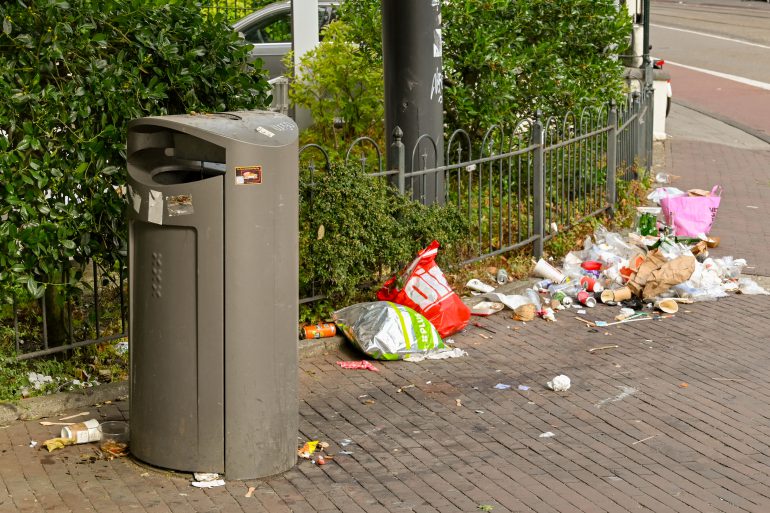‘We live on a garbage dump in Amsterdam. The city has become one of the dirtiest in the world.’ Thus begins an open letter published in newspaper Het Parool last July, signed by 38 Amsterdammers who denounced the waste crisis in the city, and the lack of urgency from the municipality to tackle the problem. This is by no means a new issue; rather it is now more like a familiar song that seems to play louder every summer. Residents highlight the city’s administration inefficiency to address the crisis; and the municipality, while acknowledging the problem, claims that residents, visitors and business owners must play their part in its solution. While everyone shares the same objective, so far nobody seems to be winning the fight.
The scenery is worst in the city centre, along with the southern district and some parts of the east and west: ripped open bags in the streets; broken underground garbage bins, many of them overflowing and with waste around containers; a litter problem in parks that is always worse during the summer; and the waste issues that come hand in hand with over-tourism. In the city centre many places lack underground containers so garbage is still left on the street for collection, where it is exposed to the elements, birds and rodents. A new problem was caused by the new deposit system for cans introduced in April 2023, leading to many people looking through trash bins and bags, leaving the contents strewn about. This has contributed to the frustration of residents, also because there are not enough collection locations for cans, and many of the machines at supermarkets seem to be permanently out of order. According to Het Parool, complaints about litter and overflowing bins increased by 61 percent in 2023 in comparison to 2022, partly because of the poor implementation of the deposit system.
The signatories of the open letter claim that urgency is lacking within the administration to truly solve the problem, with an official vision of promising a clean city only in 26 years, by 2050. At the end of the letter, they warn that ‘if this is not a top priority for the municipality, we as Amsterdammers should seriously reconsider our annual contribution to city cleaning. We should go on strike, because it can hardly get dirtier’.
Hester van Buren, acting alderwoman for waste, replied to the letter in a tone of understanding, claiming that solving the issue is they city’s top priority but acknowledging that the city is ‘not clean enough yet’. She announced a series of measures, including more street sweeping teams and more enforcement of laws about littering; introducing a new system of waste collection in the city centre, thus getting rid of trash bags; and extra waste bins in the city parks, beaches and recreational centres, along with teams stationed in the main parks to encourage visitors to clean up after themselves. At the same time, Van Buren called for Amsterdammers to implement ‘correct behaviour’, such as taking garbage out at the correct times, recycling cans and bottles and refraining from throwing away bulky waste in the streets. In sum, the municipality’s view includes a strong emphasis on changing behaviour and including city dwellers, visitors and business owners as part of both the waste problem and its solution.
However, as reported by Het Parool, many Amsterdammers claim that even if most residents behave correctly, the municipality is still lacking in carrying out its responsibilities. For example, only 58 percent of citizens’ reports (from a total of 10,728 in 2023) about overflowing bins or incorrectly placed waste were handled by the city within its 72-hour target. Likewise, despite taking out garbage within the appropriate time frames, some city dwellers still see it uncollected for many hours. The deposit problem for cans and bottles is exacerbated by the fact that around half of the deposit machines seem to be permanently out of order. Similarly, efforts to keep people from ripping trash bags and breaking bins to collect cans and bottles have so far failed, including a pilot program to place donation rings for cans and bottles, which ultimately did not show results (the rings ended up collecting more garbage of other types.)
Despite Amsterdammers and the city administration sharing the same objectives, so far the fight seems like pushing a rock up a hill, with the same problems recurring every year. A multifactorial issue, the waste crisis requires an equally multifactorial set of solutions for the middle and long term. And lots of money. In 2024 alone, 12 million euros were destined for extra staff and sweeping teams, and 10 million more are expected to come next year to design a special approach to litter. At the moment, more underground containers are being installed in the city centre, and in some areas, like the historic ‘9 Straatjes’, the municipality has started to collect waste by appointment to avoid its presence on the street. It is also expected that the city will collaborate further with the packaging industry and with companies that can provide more collection points for cans and bottles throughout the city.
The fight goes on. It remains to be seen whether actual improvement is accomplished soon, or if one year from now the waste problem in Amsterdam will be at the same point as it is now.
Written by Juan Álvarez Umbarila
